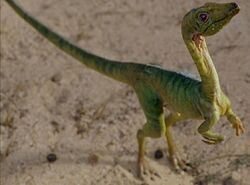So apparently I've never written a post about any compsognathids, so I'll give you a quick run down on what exactly they were. The family Compsognathidae is widely known for containing some of the smallest dinosaurs known to exist. The family's namesake is the relatively well-known Comsognathus Longipes. This dinosaur was little more than a meter long, and weighed 2.5 kilograms, making it marginally larger than a chicken. You're probably familiar with Compsognathus thanks to Jurassic Park.

Despite accurately depicting the size, Jurassic Park was incorrect in its affirmation that it possessed a poisonous bite (I can't remember if that was the books or the movies, it's been a while).
As a general rule, compsognathids were all diminutive in size, and fed primarily on insects and small lizards. However, there was one member of the group that was an exception to this rule. Twice the size and ten times the weight of Compsognathus was the family's giant: Sinocalliopteryx Gigas. This beast was 2 meters long, and weighed 20 kilograms. Although this may not seem like much, Sinocalliopteryx is an amazing find, comparable to finding a mouse the size of a bear. Sinocalliopteryx was found with many of its feathers preserved in the form of impressions, hence it's name: "Giant Chinese Beautiful Feather." The majority of its body was covered in these feathers, including the feet, an interesting feature that isn't present in most of the early theropod groups. These feathers are thought to have been for display.
Theropods have weird feet.
But the thing that makes Sinocalliopteryx the most flippin metal dinosaur ever isn't its foot feathers. To find that, you must look no further than the creature's diet. A study of the abdominal contents of a Sinocalliopteryx showed that, among several birds and mammals, Sinocalliopteryx ate dromaeosaurs. That is to say, raptors.
This is super cool because practically every other member of Sinocalliopteryx's family spent its time eating nothing but lizards and insects. This thing ate RAPTORS. Why did Sinocalliopteryx evolve this way? There are numerous possibilities, perhaps they evolved larger in an isolated area, and dromaeosaurs entered later. Actually I can't think of any other possibilities, but I'm sure there are some.
That's all for this time. I'll do another at some point.
-Athos
sources:
Long, John A., and Peter Schouten. Feathered Dinosaurs: The Origin of Birds. Oxford: Oxford UP, 2008. Print.
Paul, Gregory S. The Princeton Field Guide to Dinosaurs. Princeton, NJ: Princeton UP, 2010. Print.






.bmp)
